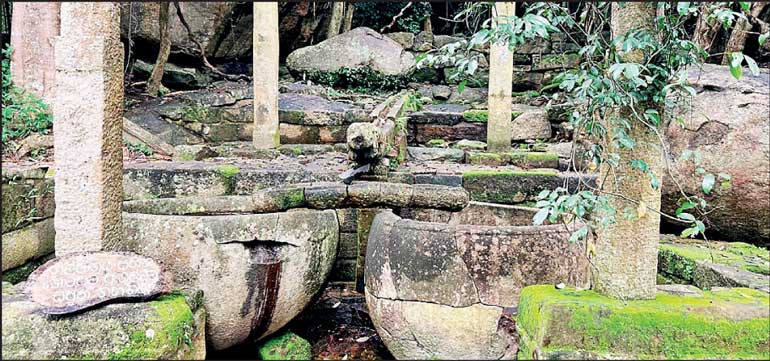Tuesday Apr 15, 2025
Tuesday Apr 15, 2025
Saturday, 20 April 2024 00:00 - - {{hitsCtrl.values.hits}}

By Don de Silva
The Rajagala Monastery, nestled atop a mountain in the Ampara district of Sri Lanka’s Eastern Province, stands as an emblematic fusion of Buddhist spirituality and ancient water conservation techniques.
Ascending 1,038 feet (316 meters) above sea level, Rajagala, known as ‘The Monarch’s Rock,’ forms the foundation of the monastery. Initiated and supported by Prince Lanja Tissa, who later became king (119 to 109 BCE), the monastery was a tranquil haven for some 500 mendicants immersed in the study and practice of Buddha Dhamma.
At the heart of this monastery’s ingenuity lies a sophisticated rainwater collection and distribution system, exemplified by the impressive stone bowls (Gal Pattaraya). These large stone receptacles are a testament to hydrological engineering of ancient Sri Lanka.
Conceived to capture rainwater and the natural course of spring water, their design reflects a profound understanding of environmental sustainability, long before this concept became a global concern.
The strategic placement of these bowls near the Dana Sala, dining hall, suggests their crucial role in the daily lives of the monastic community.
A large, stone spout channelled the water into the bowls, ensuring a steady and equitable distribution for the drinking and cooking needs.
In the shadow of these stone giants, one could imagine the quiet conversations of monks, as the soft murmur of flowing water provided a constant backdrop to their meditations and daily rituals.
These bowls, possibly once covered with lids to ensure the water’s purity, were more than mere structures; they were an intrinsic part of the monastery’s rhythm of life, reflecting a harmony between human necessity and environmental stewardship.
But the significance of the stone bowls extends beyond functional architecture. They stand as silent guardians of a heritage that revered the natural world as a vital part of spiritual life. The stone bowls, alongside rock-carved ponds, comprised a sophisticated network of water sources that sustained the daily needs of the mendicants there.
In a time when climate change and water scarcity challenge our existence today, the Rajagala Monastery’s ancient wisdom offers a mirror to our own relationship with nature’s gifts.
As you walk through the exquisite structures of this once-thriving monastery, it is easy to be struck by a sense of tranquillity that defies the centuries. The moss-laden stones, the sturdy columns that once held roofs over sacred spaces, and the echoes of a history steeped in contemplation invite you to pause and reflect.
As I gazed at the intricately designed water sanctuary, my thoughts echoed with the profound wisdom of the Vanaropa Sutta (Planters, Sn 1.47).
In the Sutta, the Buddha is questioned:
“Whose merit always grows
Kesaṁ divā ca ratto ca,
by day and by night?
sadā puññaṁ pavaḍḍhati….”
Without a moment’s hesitation, the Buddha listed groups of people, including those who construct places for drinking water:
“those who build a bridge,
ye janā setukārakā;
a drinking place and a well,
Papañca udapānañca.”
This is just one of many examples in the Tipițaka that emphasise the sanctity of enabling water for all.
The excavation work, was a joint initiative, undertaken by archaeologists from the Sri Jayewardenepura University and the Department of Archaeology, which began during 2011.
The Rajagala Monastery is not just an archaeological treasure; it is a poignant reminder of a time when conservation and spirituality were intertwined, an era that beheld water not just as a means of sustenance, but as a sacred trust to be preserved and honoured for generations.
Within this sprawling complex, the stone bowls of Rajagala remain a profound narrative of balance, reminding us that the essence of sustainability was nothing new to the people of Sri Lanka.
They call out to us, urging us to remember that in each drop of water lies the reflection of ourselves and the continuation of life’s unbroken chorus. And, we need to conserve our precious water resources for now and future generations.
*Grateful thanks to staff at Sri Lanka’s Department of Archaeology, both at Rajagala and Colombo, for their invaluable assistance.
“Significance of the Rajagala Archeological Reserve and Values Associated with it” by Prof. P.B. Mandawala
http://fhss.sjp.ac.lk/.../significance-of-the.../
Ancient Ariyakara Viharaya in the Rajagala Archaeological Project Submitted by: Permanent Delegation of Sri Lanka to UNESCO
Date of Submission: 27/02/2020 https://whc.unesco.org/en/tentativelists/6454/
(The writer is a former director of the United Nations Environment Programme (UNEP) who links traditional knowledge, environmental sciences and spiritual/cultural heritage. Don de Silva is Buddhist Counsellor and Mentor at several UK universities. He is also involved with Sri Lankan universities. He researches the Buddhism based Intangible Cultural Heritage and its relevance to sustainability, peace, unity, abundance and communication systems.)
Discover Kapruka, the leading online shopping platform in Sri Lanka, where you can conveniently send Gifts and Flowers to your loved ones for any event including Valentine ’s Day. Explore a wide range of popular Shopping Categories on Kapruka, including Toys, Groceries, Electronics, Birthday Cakes, Fruits, Chocolates, Flower Bouquets, Clothing, Watches, Lingerie, Gift Sets and Jewellery. Also if you’re interested in selling with Kapruka, Partner Central by Kapruka is the best solution to start with. Moreover, through Kapruka Global Shop, you can also enjoy the convenience of purchasing products from renowned platforms like Amazon and eBay and have them delivered to Sri Lanka.
Discover Kapruka, the leading online shopping platform in Sri Lanka, where you can conveniently send Gifts and Flowers to your loved ones for any event including Valentine ’s Day. Explore a wide range of popular Shopping Categories on Kapruka, including Toys, Groceries, Electronics, Birthday Cakes, Fruits, Chocolates, Flower Bouquets, Clothing, Watches, Lingerie, Gift Sets and Jewellery. Also if you’re interested in selling with Kapruka, Partner Central by Kapruka is the best solution to start with. Moreover, through Kapruka Global Shop, you can also enjoy the convenience of purchasing products from renowned platforms like Amazon and eBay and have them delivered to Sri Lanka.